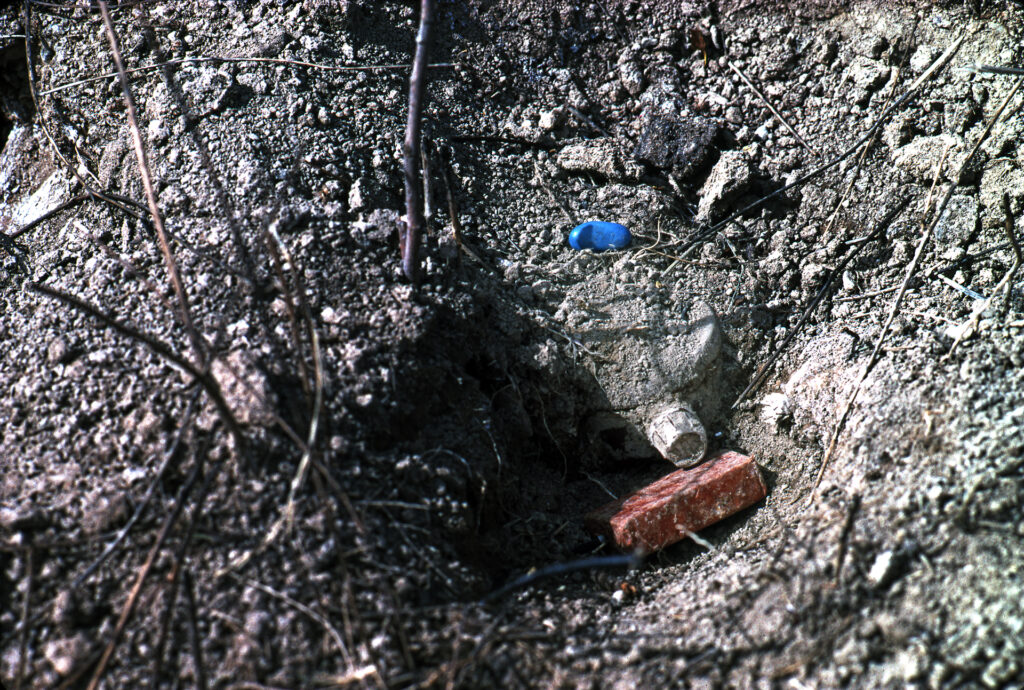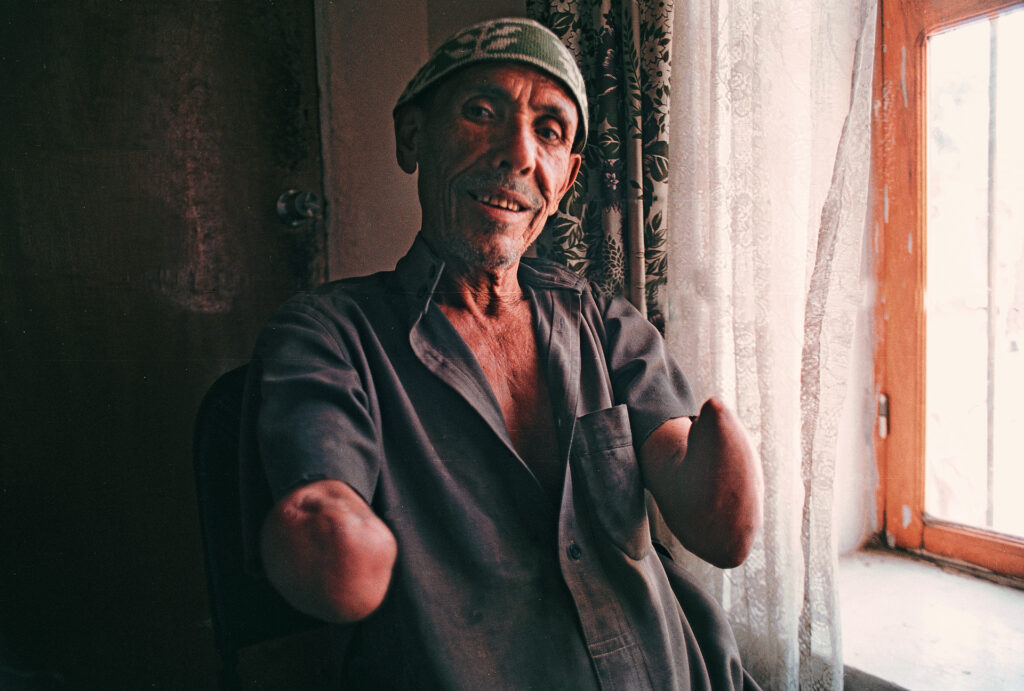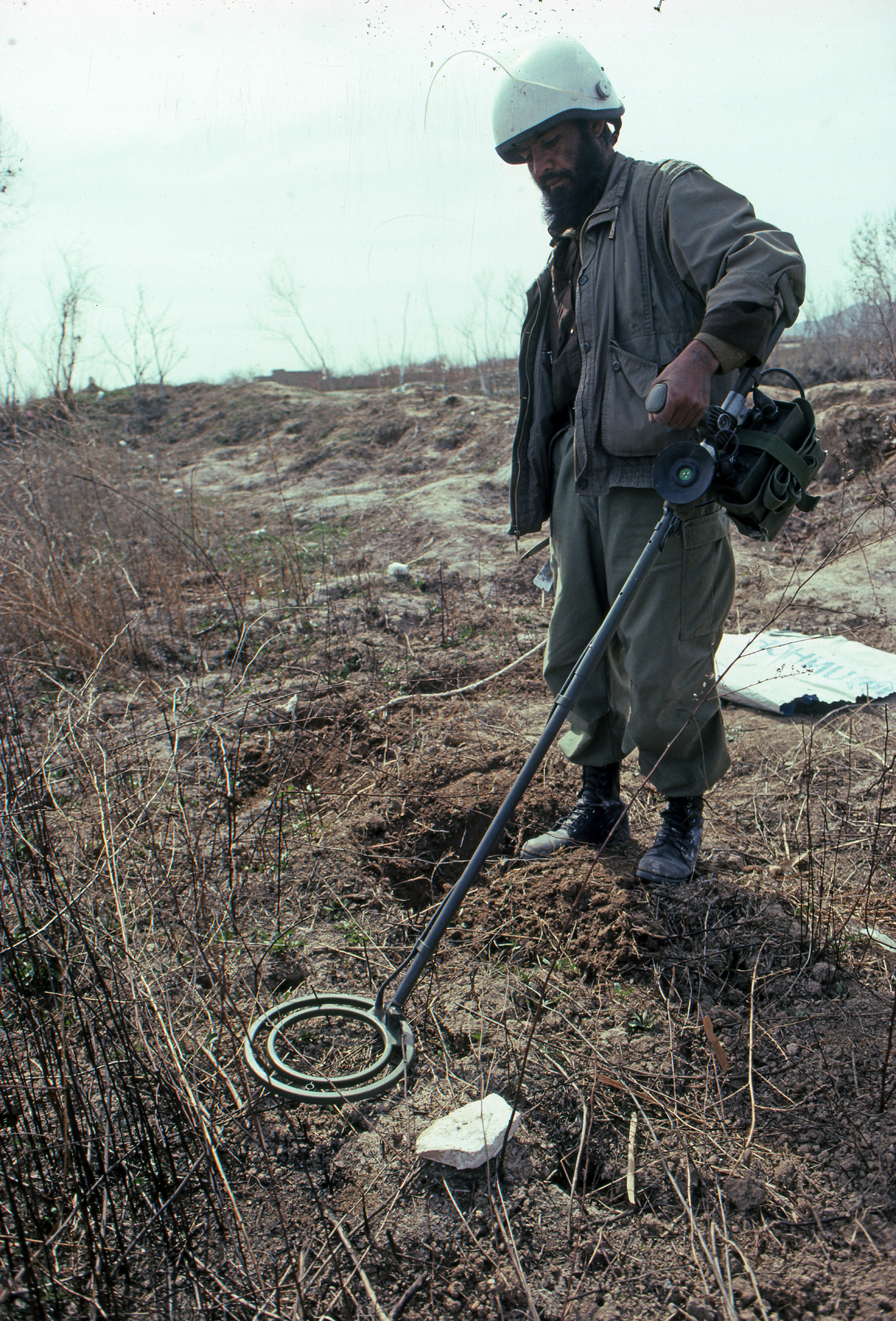Landmines: The Ones in the Ground
“If you take pictures of anyone else but deminers, or anyplace else but minefields, I will shoot this man,” the local Taliban leader says, with cold black deadly serious eyes, while pointing to my twenty-seven-year old Afghan interpreter, Abdul Wali. “Can I photograph landmine victims at the hospital,” I ask? “From here down” he says, motioning with his hands to indicate that I can only photograph victims from the waste down, – no faces. I say nothing. The rules of my visit to Kandahar, Afghanistan, are clear. The meeting is over. The black-turbaned man, in his mid-thirties, and the Taliban’s equivalent of a ‘foreign affairs attache,’ remains sitting on his colorful carpet, against a cold concrete wall in this dusty, dim, and stark room. Abdul and I rise and are silently ushered out of the shell-shocked, doorless, building, by a young armed guard. Outside, on this cold February day, a warm Landrover waits.
Abdul Wali works for the Organization for Mine Clearance and Afghan Rehabilitation (OMAR). One of six demining organizations operating under the umbrella of UNOCHO, the United Nations Office for Coordination of Humanitarian Assistance to Afghanistan.
The surrounding land is dry and flat, with towering rock outcrops in the far distance. The road from the airport into Kandahar has long since been pulverized by Russian tank traffic, bombs and artillery shells.
An old smoke-belching Russian transport truck motors around mangled parts of a destroyed bridge strewn along a parched stream bed, and road. People carry water in rusty pails along dusty streets, past war torn buildings, shelled-out, gutted and dilapidated,- without electricity or water. Wind and sand sifts through everything.
Only hours before I was flying on a small twin engine airplane belonging to the International Committee of the Red Cross, from war devastated Kabul, where, at high elevations in winter, demining is too difficult in the frozen earth and ruins of the city. And where the Taliban’s strict theocratic rule has closed schools,
and perpetrated a litany of human rights abuses, especially for women, who, are even prohibited from working, – all in the name of righteousness.
Landing at the Kandahar “military airport” I was elated to see the Landrover marked with two blue and white, United Nations – coloured flags identifying OMAR. The moment I stepped off the airplane, three men from the deminer’s vehicle quickly approached and ushered me past the dozen or so turbaned Taliban security soldiers, armed with Russian Kalashnakovs, who suspiciously scrutinized everything. I avoided eye contact with them, and we moved, with obvious purpose and direction, from the airplane to the flagged vehicle, very quickly. I was relieved to be inside the Landrover. It would have been easy for these very bored and xenophobic Taliban boys to stop me, an infidel, from getting off the airplane, or insist that I pay “airport taxes,” or search me, and tell me that cameras are forbidden, or whatever they wanted. We drove rapidly past rows of razor wire, Russian tanks, and three Mig fighter airplanes, before being waved through two final check points. The four of us laughed at how smoothly they managed to move me through the airport security. I felt lucky, and immediately among friends. Abdul Wali, the only English speaking Afghan, then explained how we needed to talk to one of the local leaders, “to secure permission for me to be here”, – in Kandahar, a Taliban stronghold, and one of the most landmined places in the world.
The vast majority of the estimated 70 people killed or injured by landmines everyday in the world have no choice but to tend their animals and fields, carry water, and look for firewood. Most landmines are hidden in places like this, where there is little distance between war and peace, poverty and corruption are rampant, and democracy is stumbling. Angola, Cambodia, and Afghanistan, account for 28 million landmines and 85% of the world’s landmine victims. Amputees are denied the ability to support their families, women are stigmatized, and land is rendered useless, on top of all the other problems facing these countries. A Mozambican has six times more chances of dying in a car accident, or murdered, than from triggering an anti-personal landmine. A Cambodian, where one in every 257 people are amputees, has about the same chance of contracting malaria or tuberculosis as stepping on a landmine. In Afghanistan, the estimated five to ten million active landmines have already killed or injured over 800,000 people, mostly civilians.
To date, over 120 countries have signed an international treaty banning the manufacture, sale, stockpiling, and use of anti-personal landmines, – that are planted in some 63 countries. But there still remains the 100 million, or more, landmines in the ground, waiting to be triggered. A blast erupts from the earth, hurls the victim into the air, and instantly shreds their trigger foot, by macerating tissue and muscle, and firing pieces of bone, clothing, shoe, and debris, deep up into that leg, the genitals, and the rest of their body. There also remains those countries that have not signed the treaty, that also happen to be some of the world’s greatest purveyors of landmines including: the United States, Israel, Pakistan, India, China, Iran, and Iraq.
The United Nations has estimated that removing the worlds active mines will cost between $33 and $85 billion. If no more mines were laid, and at the present rate of mine-clearance it would take about 1100 years to clear all the mines. While it seems that only a technical solution will change this dismal forecast, few advances in demining technology have occurred since 1942, when landmines were a western military problem, not a poor country’s humanitarian problem, before they went from being defensive to offensive weapons.
The real magnitude of the landmine problem doesn’t strike me until I’m standing in the middle of a minefield, watching deminers work. I’m told that there could be landmines within meters, maybe even centimeters of my foot, on the other side of an imaginary line joined by a few white or red-painted rocks placed by deminers.
Near the edge of town, we pull off the road, beside a “DANGER MINEFIELD” sign in English, and Arabic, and more OMAR vehicles. Abdul Wali, tells me that “this minefield was laid by the Russians to protect their nearby army encampment.” It was a dike with rows of parallel irrigation ditches, now dry and overgrown with long reeds and grass. At the perimeter of the minefield, marked with several white-painted stones, I am saluted, in true stiff military fashion, by a very formal security man, who ushers me along a narrow path to meet the commander of this demining team. Mohammad Aslam oversees the operation from a chair, beside a table with map on it, in the middle of this minefield.
Not far away are two men in white coats, medics, standing-by with their stretchers. Abdul translates, and Mohammad tells me, “you are our guest, and you must be safe here…you are free to walk in any cleared area, between the white rocks, (which in fact do not always appear so obvious to me), but you must always follow the two men that will walk in front of you.”
I watch deminer Gul Ahmad work. He is not allowed to talk while working. I learn later that he is a thirty-five-year-old father and husband who lives 600 km north of here in a village off the main road to Herat. He has been a deminer for one year with a salary of about $150./month or 10 times the average income in Afghanistan. I am not surprised to hear that hundreds more apply for deminer training than can be accepted.
Gul works a strip of land a meter wide with his metal detector, – like the ones used to find coins on beaches, but much more sophisticated and sensitive. When he hears a high-pitched squeal, Gul marks the spot with one of three small blue painted stones he keeps in his pocket. He then measures back “two hands” from that stone, where he places two more stones, about 25 cm apart. From this point, Gul knows he has a minimum of 50 cm of safe area, before he comes close to the metal sounding spot. He lies flat on his stomach and stretches his hand out from his body, and slowly scrapes dirt away from grass roots with the blade of a bayonet-sized knife. He begins to dig a trench about 4 inches deep and 3 inches wide towards his first stone, – always prodding and scraping at an angle near 30 degrees. Each probe goes deeper, and possibly closer to a landmine. It is cool in Kandahar in February but Gul is sweating. His chest is covered with a thick safety vest, and he wears a hard hat with a shatterproof visor, – equipment that may save his life, but won’t prevent him from loosing his hands or eyes. His partner sits back about 40 meters watching him, and every 20 minutes they change off.
Gul is one of a team of 24 OMAR deminers assigned by the Mine Clearance Planning Agency, (MCPA), – a United Nations supported agency that identifies, maps, marks and prioritizes minefields in Afghanistan; to clear this 42,000 square meter area, code number 24-24-01-0-069. They have been clearing this area for 26 days, and are a little more than one-half finished. They have found 103 mines, 25 unexploded ammunition (mortar and artillery shells), and 47,825 metal fragments, and they expect to be working here 20 more days. Today they have found 8 landmines. Mohammad Aslam says that “in Kabul, a team cleared a 50,000 square meter area, and found 264 mines in only four days, – because the ground was soft and there were no metal fragments.”
Every mine cleared means one less potential victim, yet, as I watch deminers work, I am astounded that there is not a better way to do this, other than prodding the ground an inch at a time. Even when other methods are used, including: sniffing machines, (gas chromatography), dogs, explosives, water hoses, flails, and tank ploughs, – manual demining is, with some exceptions, still necessary. A flail, for example, is a tank-like armour-plated machine with balls and chains attached to a rotor on the front which beat the ground, – but it is only workable on certain flat terrain, and the machine is only about 90% efficient. The efficiency of dogs is also questioned because they are distracted by weather, wind, and fatigue. When OMAR completes an area the deminers confirm for local people that a minefield is cleared, by forming a line and walking across the area. There may be more sophisticated demining methods in the future, using aircraft and satellites, robots, radars, radio frequencies, magnetometers, infrared imaging that detects heat differences between soil and landmines, and biosensors, – which make use of a particular muscle from a cow that reacts to traces of TNT. Unfortunately these technologies are either not developed or economically feasible enough, or they are only accessible to the military. So far, using metal detectors and probing by hand remains the only practical and acceptable demining method for humanitarian, (versus military or commercial), purposes.
The same person scanning and prodding is a refinement over the “old way” where detection and prodding was done by two different deminers. Gul thinks the new way is safer. One day, after work, he tells me that “…there is a different sound to the detector when it is over a landmine compared to a fragment…but I can’t rely upon that because there are many PMN’s (PMN-4 is a powerful and very common Russian-made mine), here and sometimes the metal ring around them is so rusted away that they don’t sound like mines….I have been surprised….I was sure it was another fragment but it was a real landmine…I always feel anxious about this.” And he should. A colleague of his, 29 year-old Ghallauden was blinded and lost part of one hand six months ago demining in hard ground in houses in Herat, where the Russians laid landmines on top of landmines. He told me that on the day it happened he was sure it was a fragment. “My hand was tired and I pushed my prod harder than usual…I think it was a PMN that got turned on its side, but maybe the Russians planted it that way…It felt like someone picked me up and threw me down hard…I couldn’t see…or hear…when I realized what happened I started feeling my hands and counting my fingers…I felt them gone”, says Ghallauden. Commander, his son, holds his fathers hand wherever he goes. This nine-year-old has learned about landmines the hard way.



